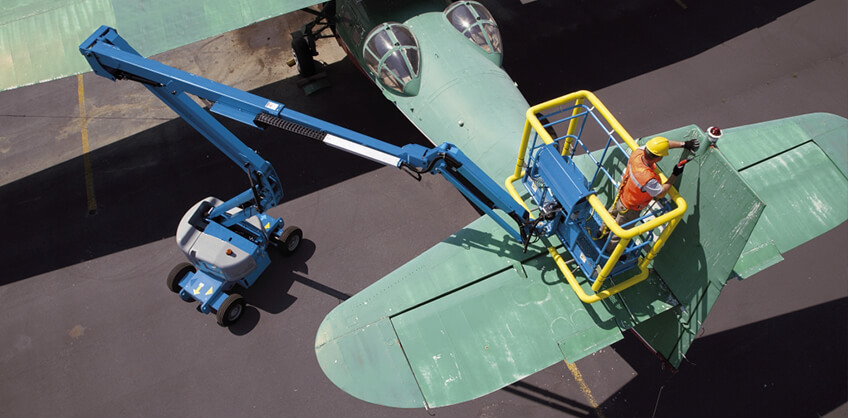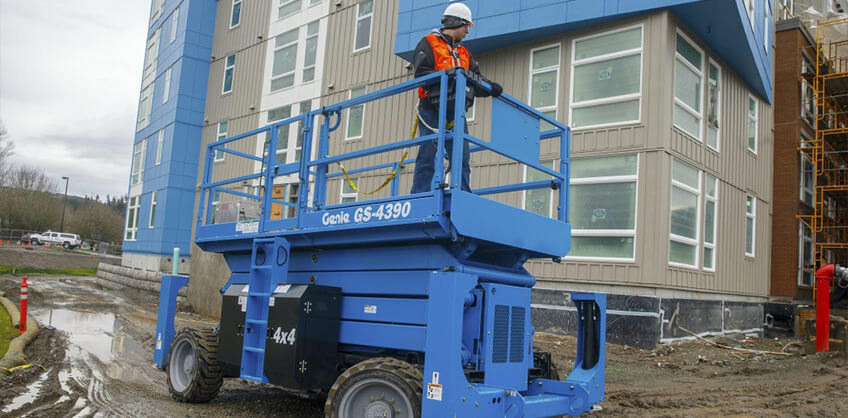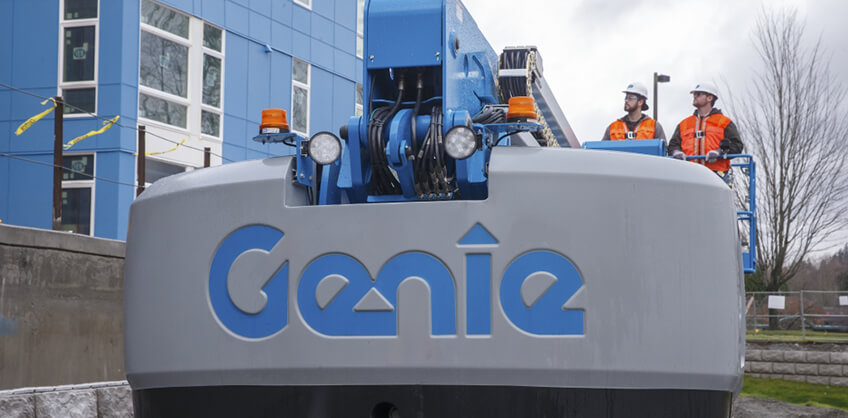A Glossary of Common Mobile Elevating Work Platform (MEWP) Terms
by Tom Meluskey - Product Trainer On Dec 12, 2019, 03:00 am
Subscribe To Aerial Pros
Filter by tags
Safety is always job one on aerial worksites. Many accidents or equipment damage happens when operators don’t fully understand the equipment. Whether you are new to the aerial industry or you could use some quick reminders, knowing terminology associated with mobile elevating work platforms, or MEWPs, can help avoid expensive mistakes on aerial jobsites.
Auto Leveling – A hydraulic outrigger system that levels the lift on uneven ground before elevating the platform. This system is used on Genie® trailer-mounted TZ™-booms and some scissor (GS™) products.
Auxiliary Functions – Lift functions that are operated by another power source than the main source (used primarily in situations to return the operator to the ground when the main power source is depleted or does not function).
Brakes
Dynamic Brake: The system that slows and stops the machine when moving. Spring-applied, hydraulically released (multi-disc) systems are common.
Parking Brake: The system that keeps the machine immobile while parked. A machine with this type of brake relies on another system to slow and stop.
Construction Model – A unit designed primarily for outdoor construction work. Standard features may include pneumatic tires (air-filled) and powerful gasoline/ LPG or diesel engines. Most construction models have rough-terrain features such as rough-terrain tires, oscillating axles and four-wheel drive to negotiate difficult, unimproved jobsites.
Contact Pressure – The weight or pressure that the machines wheels apply to the floor material. Contact pressure is used in combination with floor load to determine if the floor is capable of sustaining the overall weight of the machine. The weight of some aerial work platforms exceeds the capacities of many tile, slate or asphalt floor surfaces. Specifications provided in the manufacturer’s operators manual should be referenced to determine the contact pressure of hard-rubber-tired machines.
Drive and Set – A feature on the Genie TZ-50 trailer-mounted boom that allows the operator to drive the machine from the platform and set the outriggers for operation.
Drive Enable – A system that warns the operator when the turntable has been rotated beyond the non-steer wheel. Note: When the drive enable system is in use, the machine may drive in the opposite direction that the drive and steer control handle is moved. Use the color-coded direction arrows on the platform controls and the drive chassis to identify the direction of travel.
Drive Hubs – The wheel hub and gearbox assembly used to transfer power from the wheel motor to the wheel (used on self-propelled aerial work platforms). Drive hubs utilize a planetary gear system that reduces wheel motor speed, thereby creating greater rotary force.
Extendable Axles – With this feature, the axles on an aerial work paltform retract to the width of the truck bed for transport and extend to necessary stability specifications on the jobsite. The width of aerial work platforms is a critical factor in maintaining stability.-terms.tmb-small.jpg?Culture=en-SG&sfvrsn=82719bee_8)
Occupied Floor Pressure – The weight the floor is capable of sustaining, measured in pounds per square foot (PSF). This is used in combination with Contact Pressure to determine if the weight of the machine exceeds the capacity of the floors support system and/or surface material. To calculate floor load, multiply the machines width in feet by its length in feet to determine the total area occupied, then divide the weight of the machine by the total area occupied to determine floor load (specifications are listed in all product sales brochures). Also refer to Contact Pressure. See floor loading specifications manual PN 97897.
Front-Arm Swing – Occurs when the front boom arms (elevate assembly) of an articulating boom extend beyond any edge of the chassis during rotation. Some models have no front-arm swing and are valuable in tight areas and narrow aisle applications.
Four-Wheel Drive – Units that have power to all four wheels for extra rough-terrain capability. Most machines that have rough-terrain features include four-wheel drive.
Function Enable Switch – A hand or foot switch that, when used in combination with any function switch, enables the function to take place. This switch guards against unintentional initiation of a function.
Function Test – Pre-operation test of all aerial work platform functions performed by a qualified operator prior to each use (refer to the previous section on safety).
Grade – Refers to the severity of the slope, usually measured in percent. Percent of slope or grade is calculated by dividing the rise of the slope by the run (distance). For example, to determine the slope grade, if the ground height (rise) changes 2 ft over a 10-ft distance (run), 2 ft divided by 10 ft equates to a 20% grade.
Gradeability – Refers to the ability of the machine to drive up a grade or slope with the counterweight uphill assuming adequate traction. Usually specified as a percent, e.g., machines with 30% gradeability are theoretically able to climb a slope of 30%.
Ground Control Panel – The panel, on the turntable of a boom lift or the drive chassis of a scissor lift that allows the lift functions to be operated from the ground. There are no drive or steer controls on the ground control panel. Ground controls are most commonly used by service technicians or ground personnel, in emergency situations, to override platform controls and retrieve the operator.
Industrial Model – A unit designed primarily for indoor maintenance and/or installation work. Standard features include non-marking tires and DC electric power. Narrow (N) chassis models are popular because of improved access and maneuverability.
Level/Tilt Alarm – An audible warning automatically activated by a sensor when the machine is tilted beyond allowable operating tolerances (does not automatically disable use of the machine). When the alarm sounds, the operator must lower the boom and reposition to a firm, level surface.
Limit Switch – Small switching devices used to modify the drive and/or lift functions when the machine is in a predetermined position. For example, when the boom is raised, a limit switch is used to signal the control system to limit the drive speed to 1 foot per second.
Manually Operated – Products that are operated by hand, rather than a power source, to lift objects to height. The load platform is typically operated by a winch, which is controlled by a hand-crank that moves it up and down to position the load in place.
Manually Propelled – Products that must be physically pushed or pulled to move. They are typically on wheels or casters.
Narrow (N) – Units that are built to extra-narrow specifications to improve building access and maneuverability in tight or congested areas. There is no common dimension for narrow models, although the smaller N units are able to pass through a single or double doorway. Narrow models are generally heavier, due to increased counterweight.
Ninety-Degree Steering – The ability of the Genie Runabout™ and scissor lifts to turn at a right angle, which results in a zero inside turning radius. A very important feature in tight and congested areas.
Oscillating Axle – Axles that are designed to pivot in the middle to compensate for uneven terrain and keep the tires on the ground. Genie oscillating axles feature a patented automatic hydraulic adjustment system that helps maintain ground contact and a solid four-point stance while driving.
Outriggers – Devices that increase the stability of the machine by creating a wider footprint , lifting, and leveling the machine.
Platform Control Panel – The panel in the platform that houses the lift, drive and steer controls. The drive and steer controls are located only on the platform control panel. The most common functions found on the platform control panel are:
- Proportional-drive joystick
- Steer control thumb rocker
- Boom functions such as up/down or extend/retract
- Turntable rotate
- Platform level and platform rotate
- Jib boom functions
- Engine start and engine speed for models with gasoline/LPG or diesel engines
- Horn
- Auxiliary power
- Emergency stop
Platform Height – The maximum vertical height the floor of the work platform is capable of reaching. Often used as part of the model name. Platform height should not be confused with work height. In the U.S., work height is 6 ft greater than platform height.
Pothole Guards – Fixed or self-deploying devices used on industrial scissor lift models to reduce the possibility of a tip-over when a wheel is driven into a hole or drop-off. These devices work by lowering the chassis ground clearance near the wheels.
Pre-delivery Inspection (PDI) – Thorough inspection of the aerial work platform prior to each rental or sale to ensure that its condition is per manufacturers specifications.
Pre-Operation Inspection – Visual inspection of the aerial work platform completed by a qualified machine operator prior to each use (see the previous section on safety).
Range of Motion – Also known as working envelope, this is the work area that articulating and telescopic booms are able to access. Range of Motion charts are available for each machine model (see the previous section on range of motion).
Restricted Platform Capacity – Used by some manufacturers to specify platform weight restrictions for certain segments within the machines range of motion — indicated on the Range of Motion chart.
Rough Terrain (RT) – Describes a unit designed to travel over unimproved construction site terrain. Some units receive the RT designation with only the addition of lug tread tires. Others feature packages that include oscillating axles, more powerful gasoline/LPG or diesel engines, and four-wheel drive.
Self-Propelled – Units equipped with a hydraulic drive system that allows the machine to be driven to the work area.
Stabilizers – Devices that increase the stability of the machine but are not capable of lifting or leveling the machine.
Tailswing – Occurs when the rear end of the turntable extends beyond any edge of the drive chassis when the lift is rotated. Tailswing generally exists on all telescopic booms and some articulating booms. Most Genie® articulating boom have zero tailswing, which is very valuable for tight areas and narrow aisle applications.
Terrainability – Refers to a machines ability to negotiate terrain. Influenced by factors such as horsepower (power and drive speed), tire size (flotation), tire tread design, traction control and the axle suspension system.
Turning Radius – Equals one-half the dimension of the circle that the tire follows when the machine is turned as tight as possible. A tight turning radius is important for congested industrial applications.
Two-Wheel Drive – Units that have drive power to only two wheels. The two powered wheels on most booms are at the rear, non-steer end. Two-wheel-drive scissor lifts usually drive with the front steer wheels. Most industrial units normally only require two-wheel drive.
Working Height – The industry standard in the U.S. is 6 ft higher than platform height. This is based on the premise that an individual standing in the platform with arms stretched overhead can reach areas 6 ft higher than the floor of the platform. Work height is actually a more important dimension than platform height when you are qualifying a machine for a jobsite.
Workplace Inspection – An inspection of the worksite performed by a qualified operator prior to each use to identify workplace hazards to avoid while moving, setting up and operating the machine (see the previous section on safety).
Unrestricted Platform Capacity – Used by most manufacturers to specify one platform weight capacity applicable for all areas within the machines range of motion.
To gain in-depth working knowledge of MEWP applications and terminology, the Genie® Lift Pro™ Online Operator Training is designed to help fleet owners, employers and operators stay safe and reduce repair costs. For more information, visit https://www.genielift.com/en/support/training.
Related Posts

Recommending the Right MEWP
In today’s competitive market, we, at Genie, know that it is more important than ever for you to establish and earn your rental customers’ respect as a trusted advisor.
Continue Reading

Tire and Steering Options for MEWPs
In order for your customers to get the maximum performance out of a mobile elevating work platform (MEWP), it is important that you consider what type of tire or track is best suited for their worksite environment and needs.
Continue Reading

Why BIM?
“We think of BIM as a beginning-to-end concept,” says Josh Lyons, architect for The Thrasher Group, an architecture, engineering and field services company, headquartered in Bridgeport, W.Va.
Continue Reading


-terms.jpg?sfvrsn=bb8c032e_21)